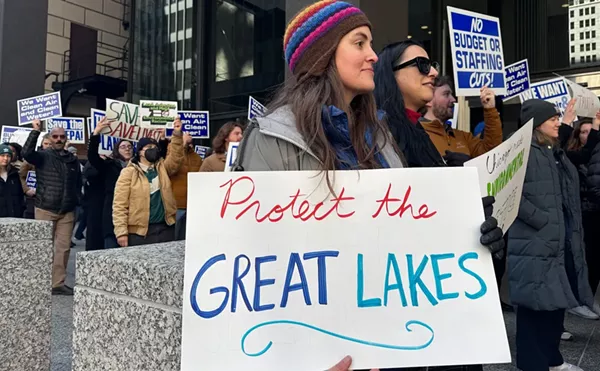Fortunately, not everyone buys into that approach. For those whose conscience is still in good working order, the act of sincere apology can become a much-needed experience of release and unburdening. Sometimes doing the right thing can set you free.
In a belated commemoration of the 175th anniversary of the establishment of the Bureau of Indian Affairs, Native Americans finally received the closest thing they will probably ever get to an apology from the United States government. Anybody who knows anything about how the United States was “founded” shouldn’t have to ask what needs to apologized for. As the remarks given by Kevin Gover, assistant secretary of Indian Affairs in the Department of the Interior, make clear, the apology for the near-genocide of America’s native population is long overdue. Granted, an apology by itself can’t erase the past nor rectify the lingering damage that has carried over to the present, but maybe it can be a first step toward establishing a better future.
Here’s some of what Gover had to say on Sept. 8:
“In March of 1824, President James Monroe established the Office of Indian Affairs in the Department of War. ... (T)his institution must first look back and reflect on what it has wrought and, by doing so, come to know that this is no occasion for celebration; rather it is time for reflection and contemplation, a time for sorrowful truths to be spoken, a time for contrition.
“We must first reconcile ourselves to the fact that the works of this agency have at various times profoundly harmed the communities it was meant to serve. From the very beginning, the Office of Indian Affairs was an instrument by which the United States enforced its ambition against the Indian nations and Indian people who stood in its path. And so, the first mission of this institution was to execute the removal of the southeastern tribal nations. By threat, deceit and force, these great tribal nations were made to march 1,000 miles to the west, leaving thousands of their old, their young, and their infirm in hasty graves along the Trail of Tears.”
Gover talks about some of the tactics and actions used against the native people. Most of it should be no surprise to Americans who grew up watching cowboy movies and television programs in which “injuns” are usually treated with less respect than a spittoon. The ethnic cleansing that took place was brutal with early biological warfare in the form of smallpox-infested blankets and foisting alcohol on a culture that had no experience with the debilitating drug. They eliminated bison herds that were primary sources of food, clothing and shelter. There were massacres of women and children, treaties that weren’t worth the paper they were written on. And he mentions the sites of specific atrocities such as Sand Creek, the banks of the Washita River and Wounded Knee. Anyone searching for more detail of the devastation might read such excellent books as Howard Zinn’s A People’s History of the United States or Dee Brown’s Bury My Heart at Wounded Knee.
Gover goes on to do what was once unthinkable.
“I do not speak today for the United States. That is the province of the nation’s elected leaders, and I would not presume to speak on their behalf. I am empowered, however, to speak on behalf of this agency. ... We accept this inheritance, these wrongs, we acknowledge what the institution we serve did. We accept this inheritance, this legacy of racism and inhumanity. And by accepting this legacy, we accept also the moral responsibility of putting things right. … Never again will this agency stand silent when hate and violence are committed against Indians.”
This just might set the standard for how an apology ought to be delivered. Don’t try to explain it all away, or belittle it, or dismiss it. Just face up to it and deal with it. Period.
To date, a formal apology has never been made to African-Americans for enslaving and brutalizing our ancestors. For some strange reason our national leaders just can’t seem to wrap their political lips around the words, “I’m sorry.”
President Bill Clinton floated the idea a few years ago and was quickly silenced. Once an apology is given the specter of reparations will raise its haunted hand.
Likewise in Australia. The Olympic Games are taking place there and aborigines are staging protests to draw global attention to the numerous ways in which they have been abused since the first English convicts were dropped off there to serve lengthy sentences far from home.
As what is now known as Australia took shape, the native aborigines suffered in the name of “civilization” in virtually the same ways as Native Americans. Most aborigines now live on reservations and have experienced many of the same shell-shocked symptoms of oppression such as an extraordinarily high rate of alcoholism. Until the mid-’70s, it was legal for white Australians to kidnap aborigine children from their families and deliver them to white families where they were trained in how to forget their own culture and learn the ways of the conquering majority. Aborigines were rarely told where their children had been taken.
Obviously not all white Australians approve of what their country did, and when I was there more than 15 years ago, I spoke with many whose sense of shame and outrage was boiling over. But that outrage has yet to reach the highest levels of government, because the prime minister staunchly refuses to issue any apology for past wrongs. Sorry, but that just won’t do. Could cause a disturbance, you know? Keith A. Owens is a Detroit writer, editor and musician. E-mail [email protected]






